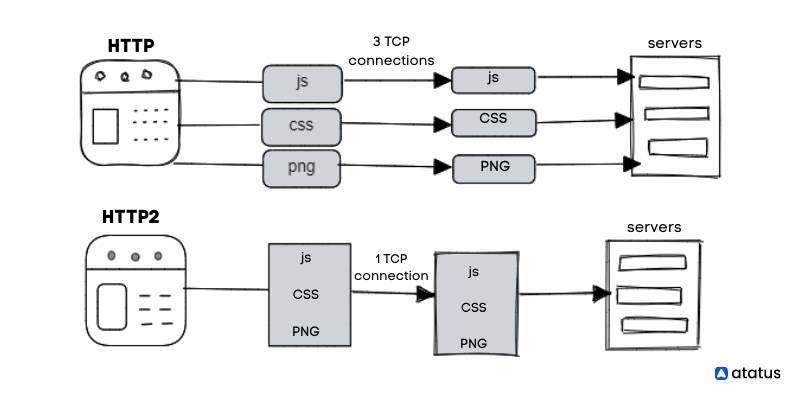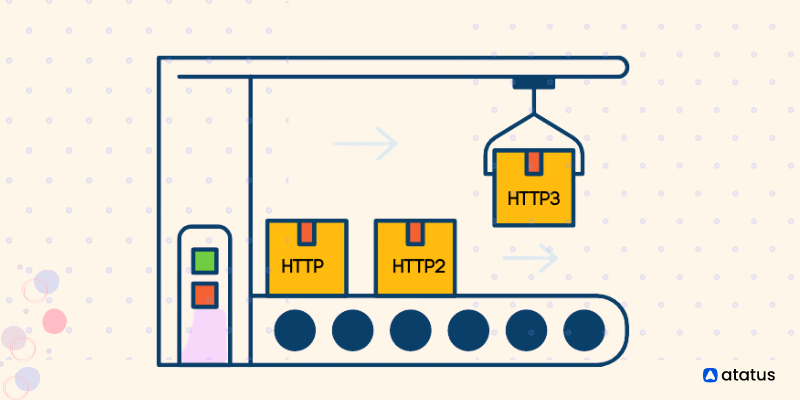A Layman's Guide To HTTP/2
HTTP stands for Hypertext Transfer Protocol and is the backbone of the World Wide Web. HTTP/2 is the second major version of the HTTP protocol, which offers a performance improvement over its prototype.
The new protocol has been in development for a long time, with the first draft published in 2012 and it was finalized in 2015.
In recent times, HTTP is the obligation that boards almost all of the networks. When a user opens a page, the browser makes an HTTP request en route to an Internet server that returns the text that the user is right away seeking.
Hypertext Transfer Protocol (HTTP) is a set of protocols that permits web users to interchange web page information. Since its launch in 1991, There have been four HTTP variants.
HTTP/2 increases data transfer speeds and magnifies the performance of web pages.HTTP 1.1 is still used, but many websites are switching over to HTTP 2 for faster loading times.
Here we can get covered the following topics;
- What is HTTP/2?
- Conspicuous of HTTP/2
- HTTP/2 vs HTTP
- Optimizing your website for HTTP/2?
- Challenges in employing HTTP/2
- When is HTTP 2 necessary?
- Introducing HTTP/3 - What's New and Improved
What is HTTP/2?
The foremost goal of HTTP 2 is to reduce latency and avoid head-of-line blocking. It allows multiple requests to be transmitted when one or more requests involve waiting for data from another server.
Hence, HTTP2 can be used by web browsers, servers, CDNs, and other intermediaries such as load balancers and reverse proxies.
HTTP/2 is an up-to-date version of the HTTP protocol. It was systematized to be more credible, especially for high-traffic sites. while simplifying the architecture of a website's backend.
It does not support multiplexing as its predecessor did, which depicts that only one request can be sent at a time from a client to a server, but the server can send multiple responses at once (in parallel)
Conspicuous of HTTP/2
HTTP 2 is a protocol that’s been around for a while but it has been newly implemented by Google in 2015 and as of 2018, it has become the new standard. The subsequent are the efficacies of HTTP/2;
- Reduced latency as the round trip time (RTT) between client and server is reduced from an average of 100ms (HTTP1) to 10ms (HTTP2).
- Header compression: It reduces the size of text-based information exchanged between client and server, which can reduce bandwidth usage by up to 80%.
- Server push: It allows the web server to send data that the client has not yet requested in anticipation that it might need it soon.
- Compression: This reduces network bandwidth by up to 70% by reducing the size of text-based content like HTML, CSS, and JavaScript files before they’re transferred over the Internet or sent to a user’s browser ·
- Stream prioritization: This allows tracking of stream priorities, which provides a mechanism allowing connectionless streams to be transmitted without precedence conflicts, ensuring all streams operate at their highest quality.
HTTP/2 Vs HTTP
Predominantly, the cardinal contradiction between HTTP 1 and HTTP 2 is it’s based on a binary format rather than text-based.
When you send data through an HTTP 2 connection, you’re sending binary code instead of text-based messages like "GET /index.html” or “POST /login_form".

Another variation between HTTP 1 and HTTP 2 is it uses multiplexing instead of multiple TCP connections to send requests and responses back and forth between the client (e.g. a browser) and the server (e.g. www.google.com).
Multiplexing acquaints one TCP stream is used for all requests, responses, and data instead of utilizing separate connections for each request/response pair like HTTP 1 does.
Besides, HTTP 2 and HTTP 1 are based on a binary format rather than a text format. In HTTP 2 requests are sent in the form of a series of frames that are then used to devise a response.
Optimizing your Website for HTTP/2
The first thing that needs to be done to optimize your website for HTTP/2 is to ensure that you are using the HTTPS protocol.
By turning on HTTPS (if it is not already activated), you can reduce page load time by around 20%.
According to Google, Http/2 serves content more efficiently, which will crop up in a swifter loading website and fewer data requests.
Make sure that you have a Content Delivery Network (CDN) setup if your website makes use of a lot of static assets, such as images and JavaScript files.
HTTP2 improves performance which is visible in many aspects: speed (web pages load faster), cost (bandwidth usage), and power consumption (reduced network overhead).
Challenges in employing HTTP/2
HTTP 2 servers typically come with some drawbacks that developers need to know to employ Http/2 protocols.
They may require additional dependencies or configuration settings when set up on top of existing infrastructure.
They often need more time to perform start-up operations and then scale. And they may not comply with existing network policies.
When is HTTP 2 necessary?
Apple's HTTP 2 server has been recommended for use by the company over HTTP 1.1 and SPDY, due to performance benefits.
Amazon Web Services, GoDaddy, Microsoft Azure, and several other major players in the online services industry all support a multitude of HTTP servers, including HTTP 1.1 and SPDY, but also HTTP 2.
According to Mozilla, "the major HTTP protocols are all speeding up because they are being forced to."Some other advantages of the protocol include the use of compression algorithms and TLS encryption.
Introducing Http/3 - What's New and Improved
HTTP/3 replaces the ageing HTTP protocol. The new protocol is a long-awaited upgrade as it will provide many enhancements over the previous one.
Google Chrome is an example browser software that supports HTTP/3 protocol and can be used as an HTTP/3 client.

HTTP/3 offers more improvements over HTTP/2. It is more stable and also affords better encryption.
HTTP 3 was designed to be a replacement for HTTP 2 and The subsequent are some of the new aspects of HTTP 3.0:
- A push-based protocol that declines server latency by nearly 50% evicting unessential request round trips.
- Profound performance and resilience to connection failures with 5 simultaneous TCP connections per peer.
- End-to-end encryption for all requests and responses for privacy and security.
Wind Up: Time To Procure HTTP/2 On Your Site?
HTTP/2 is an improvement on the original HTTP protocol. Some improvements that it has are binary framing and header compression. Although it is not as popular as HTTP/1.x, some websites still use it. This version of HTTP is used by Google and other large websites to help secure their websites
It has attributes that reduce page load times and assist developers to intensify performance in other ways by using fewer connections and steering how long a connection persists in the browser.
Monitor your application with Atatus API Failure Monitoring
To Scrutinize and integrate your web and backend apps with creditable, real-time insights, opt for the full-stack monitoring platform, Atatus
Atatus provides a precise outline of all the HTTP Failures that crop up in your app which impacts your users. Acquire in-depth details of the request parameters, varied HTTP failure codes conjointly, and custom data that you can pass to simplify your failures.
To concede the root cause bask into failures thus With each failure, you get the entire set of HTTP headers together with custom data that you pass on with every transaction.
By dint of detailed information such as to request parameters, and user agents, furthermore, you can root cause the issues quicker.
Employing Atatus you can find Out how many 4xx, and 5xx codes impact each endpoint, Also familiarize yourself with the varied status codes that each endpoint receives.
Aggregate, search and filter the codes to see how each endpoint is encapsulated by these API failures along with relevant session traces and exceptions.
To get to know about Atatus platform Schedule a Demo!
#1 Solution for Logs, Traces & Metrics
APM
Kubernetes
Logs
Synthetics
RUM
Serverless
Security
More


